Expert insights to master TCPA compliance in 2025 and beyond

The last episode of our webinar series, “The 2024 FCC compliance recap: Preparing for the year ahead,” was a hive of enlightening discussion, addressing the impending modifications to lead generation, primarily characterized by upcoming regulations from the Federal Communications Commission (FCC).
Our Chief Revenue Officer, Margaret Wise, was joined by knowledgeable guests Alexandra Krasovec, Partner at Manatt, Phelps & Phillips, LLP, Craig Ready, General Counsel at Launch Potato, and Gary Kibel, Partner at Davis+Gilbert, LLP, to shed light on this topic.
Recapping one-to-one consent
On a high level, as Margaret explains, the FCC regulations taking effect on January 27, 2025, introduce updates and changes to the TCPA rules. This means you need one-to-one consent from consumers before reaching out to them (if using an autodialer or regulated calling technology).
They must have explicitly consented to be contacted by your brand, and you must have proof of this consent. Additionally, they should be expecting to hear from your brand specifically and on the topic for which you are contacting them.
Introducing the concept of “consent journeys”
Craig has tackled this issue from multiple angles because Launch Potato owns digital media brands in both consumer finance and the sweepstakes verticals. In the sweepstakes content experience vertical, they already had a solid one-to-one consent process in place with many of their partners. The main challenge there was ensuring that the calls and texts were logically and topically associated with the interaction that prompted the consent.
To address this, they focused on the rule’s language, which requires that the calls and texts be logically and topically linked to the interaction that led to the consent. For example, if a user is taking a survey on a sweepstakes website, they might answer questions before seeing an ad and giving consent to be contacted by the advertiser. If the website is primarily for sweepstakes, an ad for health insurance wouldn’t naturally fit. However, if you show the user some health insurance-related content information or ask a few health insurance-related questions before the ad, it creates a logical and topical connection.
This approach, as Craig explains, helps ensure that the user is making an informed decision about giving their consent for the health insurance company to contact them.
On the consumer finance side, they hadn’t previously implemented the one-to-one consent requirement, but the logical and topical aspect was already well-handled. For this reason, they’ve been experimenting with integrating consent prompts throughout the marketing funnel, rather than just at the end. This way, users aren’t overwhelmed by a long list of names and offers at the final step. Instead, they are asked for consent earlier in the process, such as after providing their name, email, and phone number and answering a few questions. This approach ensures that users are more aware of the specific offers and companies they are consenting to, making the process smoother and more transparent.
In Craig’s view, the FCC commentary about the website’s purpose is less relevant since the actual rule focuses on the logical and topical connection between the user’s interaction and the subsequent calls or texts. By showing users relevant content and asking targeted questions, they can better align with the rule’s requirements and ensure a more user-friendly consent journey.
What are the legal requirements defining logical and topical consent and multi-step processes?
As Gary advises, you need to strike a balance between where consent is legally required and where it is advisable for the consumer’s benefit. However, there’s also the issue of consent fatigue, where people are bombarded with numerous pop-ups and notices. The more they see, the less likely they are to read them carefully. This creates a catch-22: while you are obligated to obtain consent for various processes, overwhelming consumers with too many disclosures can lead to confusion.
Regulators might even argue that this confusion constitutes a dark pattern, as people may not fully understand what they are consenting to.
At the end of the day, what is the consumer really consenting to? Gary believes it’s crucial to make this clear at the right point in the journey. This way, you can argue that the consent is highly effective because it was unavoidable for the consumer, logically and topically linked to the specific action, and not mixed in with other notices, consents, and pop-ups.
As Alexandra explains, when the FCC created this rule, they primarily had one specific use case in mind: preventing the need for consumers to give consent to hundreds or thousands of marketing partners. However, the regulations they adopted are broad and apply to everyone, including the requirement for prior express written consent. This raises many interesting questions, such as the one Craig brought up about logical and topical consent.
The FCC likely wasn’t thinking about sweepstakes (and other digital content verticals) when they formulated the rule, and Alexandra has confirmed with the FCC that they didn’t consider certain other scenarios. Nonetheless, the regulation applies universally, so you need to find a way to comply.
Historically, many sellers would approach Alexandra, asking for the necessary language and then simply placing it on a page. But that’s only part of the issue. The real challenge is how you present the consent. What does the consumer understand about the consent they are giving, how will it be applied, and what is its scope? Alexandra has seen courts already emphasizing the importance of logical and topical consent before the FCC even mentioned it. This means it’s not just about the one page; it’s about the entire consumer experience.
That’s why Alexandra always asks her clients to send her their entire website or digital experience flow, not just a single page. This approach provides an opportunity to examine and improve the entire consent journey. It also ties into another point Craig mentioned: exploring different methods for collecting consent. This development forces sellers and lead generators to rethink their processes and consider alternative and more transparent ways to gather consent. According to Alexandra, there’s a significant benefit in increasing consumer awareness and engagement.

According to Craig, there’s still a healthy debate around this topic. However, from his perspective, if the overall result is an increase in quality and the kind of consumer stickiness Alexandra mentioned, that’s a positive outcome. If the quality of leads improves, it will likely benefit the industry as a whole.
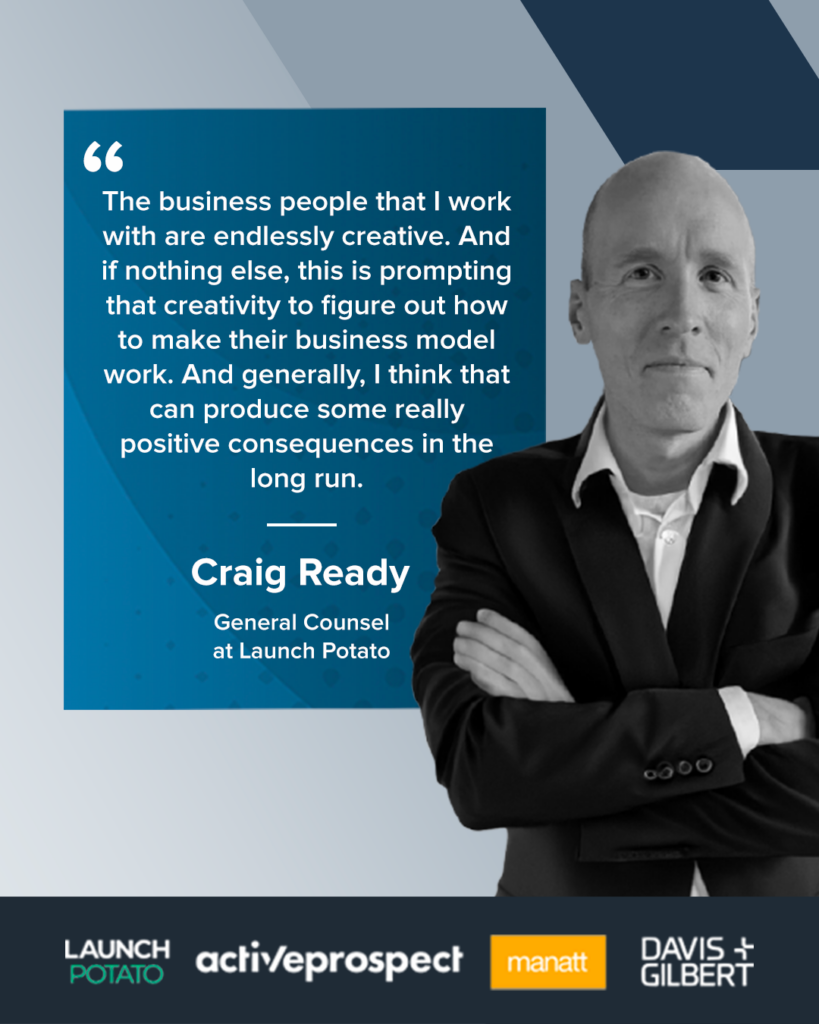
Ultimately, as Gary explains, if you’re paying $1 per lead and only one out of 20 is successful, it might be more beneficial to pay $5 per lead and have 50% of them convert.
Margaret adds that while you might be paying more upfront, reducing the number of low-quality leads can save your organization a lot of intangible costs. You’ll make fewer calls, process less information, and avoid the numerous calls and administrative tasks that often come with poor leads.
Are you required to obtain and prove one-to-one consent for leads that come in before January 27?
As Alexandra states, the answer is yes, you need to obtain compliant consent for anything you plan to use after January 27, 2025. This means that any leads currently in your pipeline or existing customers who have previously given express written consent must have their consent updated to remain valid after January 27.
So, whether you’re planning to implement new rules or you already have an existing customer database, you have some work to do to ensure their consent is valid for the implementation deadline.
Is it compliant to use a select all button for multiple brands when obtaining consent?
Gary shared it’s possible to develop an interface that makes it very clear what someone’s consenting to. But, he would stay away from pre-checked boxes because you may have a hard time arguing that the consumer knew what they were consenting to.
Alexandra agrees with Gary that it’s best to avoid prechecked boxes, as they pose risks not only with regulators but also in court. However, she has seen a few presentations where, in specific contexts, this approach might be feasible.
This discrepancy often arises because the FCC focuses on narrow use cases rather than considering all scenarios. Ultimately, the rule is that consumers must be able to choose which entities can call them, and you cannot force them to select all. While you can encourage selection, doing so might affect the enforceability of the consent.
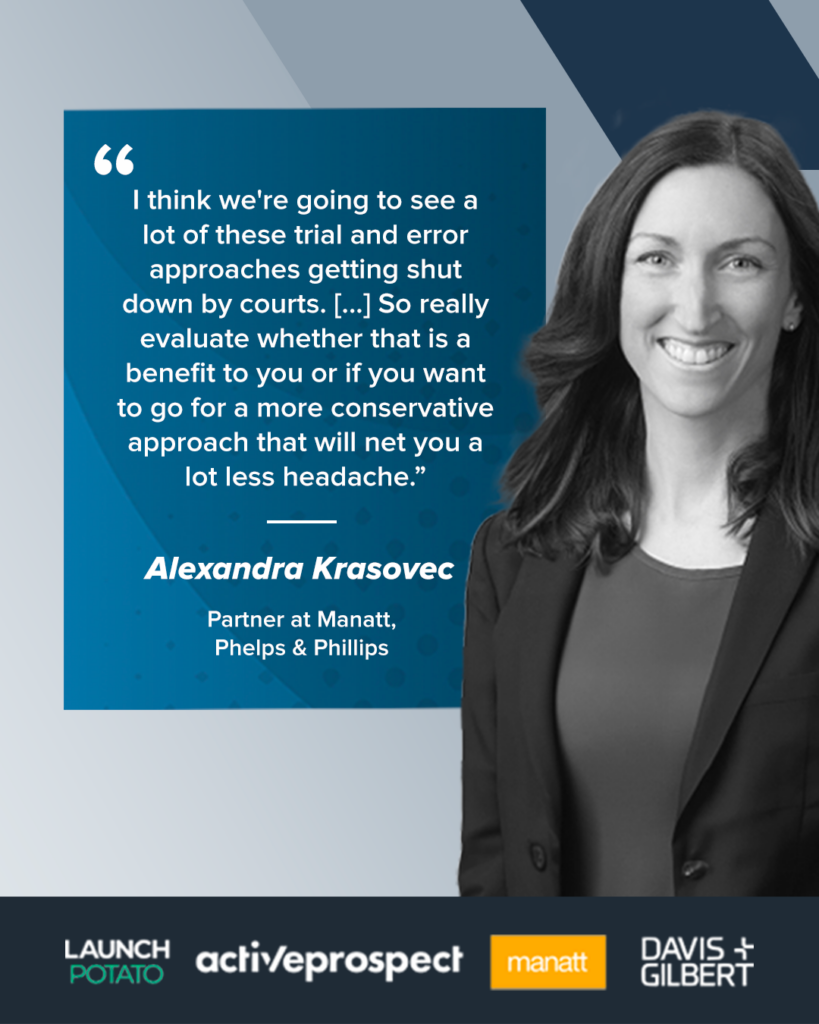
How to obtain consent for older leads and determine the limits of contacting them
As Alexandra explains, if you currently have prior express written consent, you can still use it to contact consumers before it expires in January. This means you can market to them and request additional consent through various methods, such as guiding them through new consent flows or creating targeted outreach. This is your final opportunity to make TCPA-regulated contact to ask for one-to-one consent. After January 27, you’ll need to rely on non-regulated methods for any further outreach.
Alexandra also notes that if your leads are very old, you should question whether the existing consent is still valid. Stale leads are especially vulnerable to TCPA claims, and even if the consent was originally given, these leads often lead to more complaints. She advises to proceed with caution.
Understanding the use of AI in lead generation
In February of this year, the FCC released a declaratory ruling that confirmed that any AI-generated artificial or pre-recorded voice, including voice cloning and messages that make the machine sound like a live agent, falls under the TCPA’s artificial or pre-recorded voice provision. This means that if you use such technology to make calls, you must obtain consent under the TCPA. The type of consent required depends on whether the call is informational or marketing.
But that’s not the end of the story. As Alexandra continues to explain, the FCC is also considering further rulemaking to tighten consent requirements. This could mean that callers need to obtain specific consent to use AI technology, along with potential disclosure requirements. For example, if you use AI on a call, you might need to inform the consumer that they are interacting with AI. Similar disclosure requirements could apply to AI-generated text messages.
This brings up another issue mentioned briefly in the FCC’s notice of proposed rulemaking: AI technology can be used in ways that don’t involve artificial or pre-recorded voice but could still implicate Automatic Telephone Dialing System (ATDS) regulations. If you’re using AI to generate voice messages or text messages and an ATDS to send them, you could run into compliance issues.
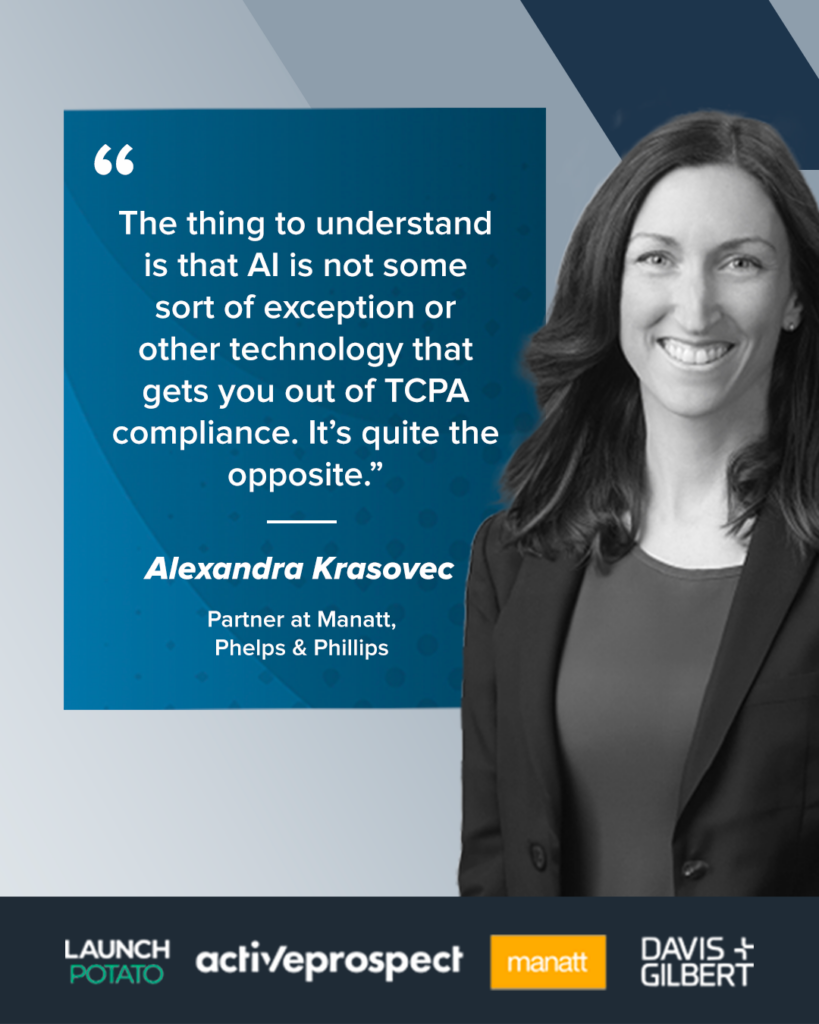
If you’re using AI in your operations, Alexandra suggests you should consult with your TCPA legal counsel to understand the consent and disclosure obligations and ensure you are in compliance.
To this regard, Gary explains how two states, Colorado and Utah, have recently enacted new AI laws. Utah’s law is already in effect, while Colorado’s will take effect in early 2026. Both laws mandate that consumers be informed when they are interacting with an AI platform. Utah’s law primarily focuses on disclosure, but Colorado’s goes further, requiring detailed impact assessments for AI developers and deployers. These assessments must include information on how the AI system learns and trains, with many of these disclosures made public while still protecting trade secrets.
If you are using AI generative voice service during in-bound or outbound calling, whether as a developer or deployer, you could be affected by these new state laws. Even if you are just using a third-party AI service, it’s crucial to ensure that the provider complies with all applicable laws. Additionally, California has had a chatbot law for over a decade, requiring disclosure to consumers about whether they are interacting with a chatbot or a real person.
As more states are expected to enact AI laws in 2025, the regulatory landscape will become increasingly more complex. Gary advises to stay informed about state-level regulations to ensure compliance and avoid potential legal issues.
What to expect in 2025
According to Gary, we can expect a significant drop in lead volume, along with increased costs per lead. This trend will likely continue into 2025, especially after the election. The most impactful change for the marketing industry will be a shift in leadership at the Federal Trade Commission (FTC), which has historically taken an aggressive stance on various consumer data use and collection issues.
However, Gary doesn’t anticipate immediate changes in January. It will take several months for new commissioners to be appointed, but eventually, we will see a shift in regulatory priorities. While there may be less regulatory action, the new priorities will need to be closely monitored.
Privacy laws are also undergoing radical changes due to the proliferation of new state privacy laws. In total, 19 states have passed such laws, and they contain some unique provisions that may not be widely recognized. For instance, Maryland’s data minimization requirement, which will soon take effect, mandates that businesses only collect personal data that is reasonably necessary or proportionate to provide a product or service requested by the consumer.
Gary also predicts an increase in consent fatigue, as businesses will need to present more disclosures, pop-ups, and notices to consumers to use data in ways they might not expect.
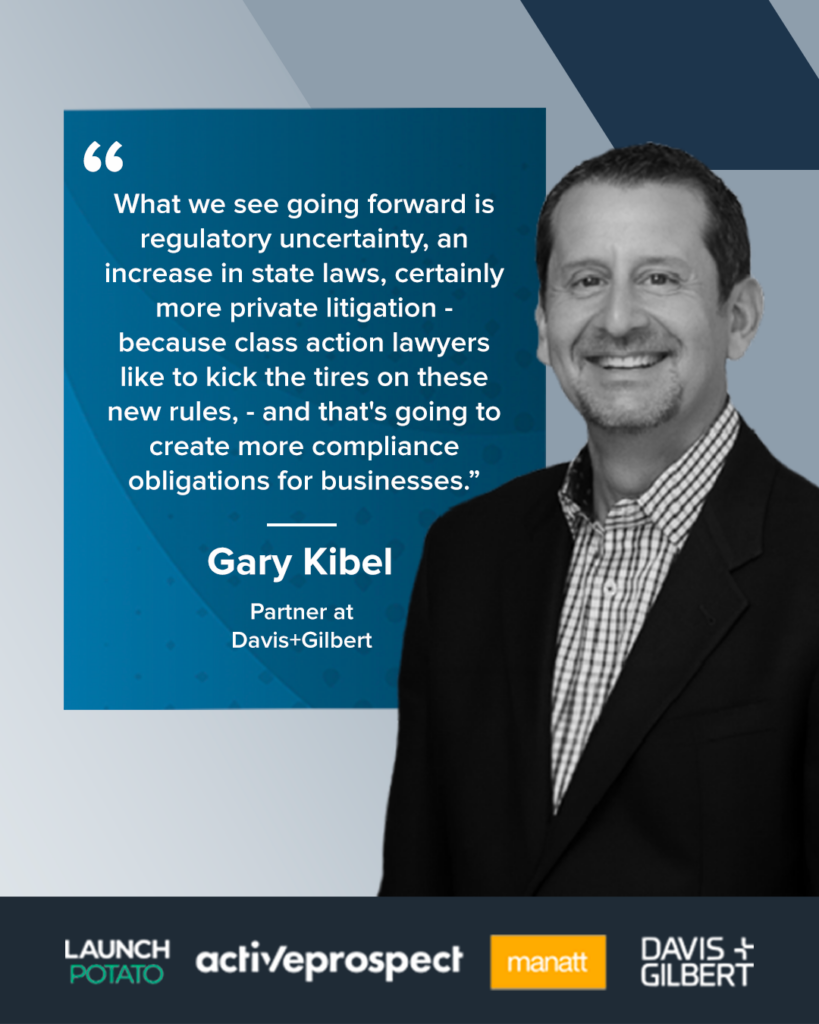
Takeaways
Here are the main takeaways from our webinar “The 2024 FCC compliance recap: Preparing for the year ahead,”:
- The new upcoming FCC regulations have generated a range of emotions and responses in the lead generation industry.
- There is a need for businesses to adapt and prepare for these regulations, including obtaining compliant one-to-one prior express written consent from consumers.
- Generative AI is increasingly being used in lead generation, but it’s essential to understand how it fits within the TPCA’s existing structure and potential future regulations.
- The use of generative AI in lead generation could potentially increase the risk of legal disputes.
- There is a need for businesses to prepare for potential changes in US state privacy laws and the impact these could have on lead generation.
Watch the full episode now and go back to watch our entire FCC webinar series to get all the expert insights you need in order to face new compliance challenges with confidence.
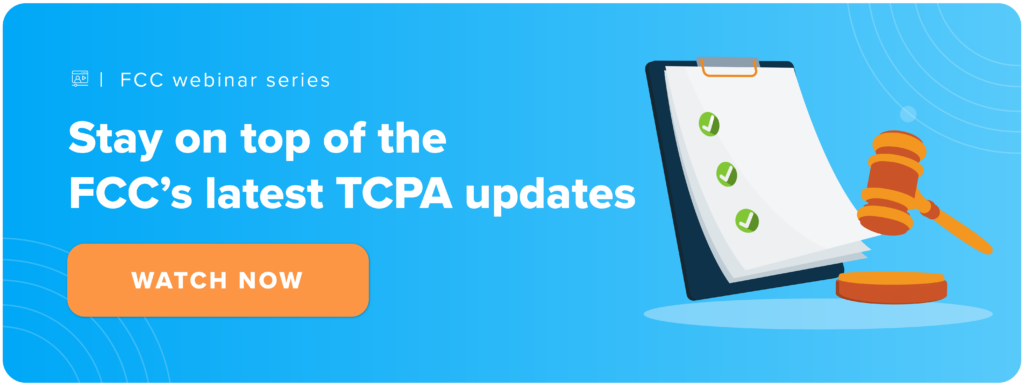
DISCLAIMER: This page and all related links are provided for general informational and educational purposes only and are not legal advice. ActiveProspect does not warrant or guarantee this information will provide you with legal protection or compliance. Please consult with your legal counsel for legal and compliance advice. You are responsible for using any ActiveProspect Services in a legally compliant manner pursuant to ActiveProspect’s Terms of Service. Any quotes contained herein belong to the person(s) quoted and do not necessarily represent the views and/or opinions of ActiveProspect.

